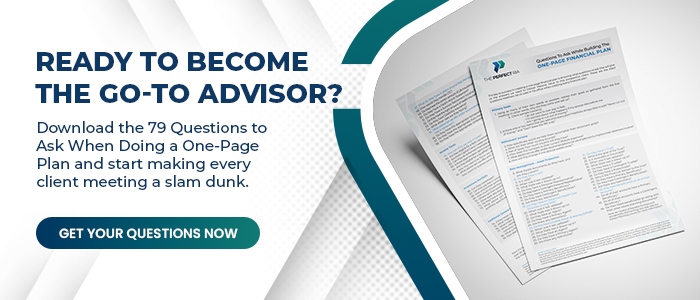6 Important Fundamental Elements for an Effective Onboarding Process
Have you included these six fundamental elements in your process of success? Micah Shilanski shares what you need to succeed when onboarding new clients.
5 min read

Financial Planner, CFP®
So, that prospect just agreed to hire you. Congrats! Now what?
Do you have a solid onboarding process?
Or are you still flying by the seat of your pants, keeping a half-step ahead of your new client?
I hate to break it to you, but if your onboarding process isn’t written down for your team to implement, you don’t have a process; you just have imaginary guidelines.
Until you get your process down on paper, you’re just setting yourself and your team up for failure—you may have hired rockstars, but they aren’t clairvoyant. So, let’s take some time to create your onboarding process today.
Here are six things your onboarding process needs so that you can deliver massive value every step of the way.
Consistency
By agreeing to work with you, your clients Bob and Sue are about to make the largest financial transaction of their lives.
Through this process, there will be a little voice in the back of their minds questioning if you’re the right person for the job.
You can help put your client at ease by being a steady, guiding hand, not only through their onboarding experience but throughout your entire working relationship. Be mindful that you’ll likely be working with Bob and Sue for the rest of their lives.
Be seen as someone whose advice they can genuinely value because you’ve told them exactly what’s going to happen—and what could go wrong—along every step of their retirement. Make sure you’ve cleared any mystery about where their money has gone and what’s going to happen next.
Make sure your process is predictable and allows Bob and Sue to see what’s coming down the road before they get to it. You should never drop any surprises during a client meeting, and make sure your pre-meeting communications include what to expect next.
Remember, your clients trust you with their entire life savings, and even though you’ve been through this process a hundred or even a thousand times, this is always Bob and Sue’s first, and they are anxious about what to expect.
Clear expectations
Too many advisors make setting expectations way harder than it needs to be. It boils down to this:
Likely, Bob and Sue had never worked with a financial advisor before or worked with a really crappy one.
Bob and Sue don’t know what to expect from working with you, so you must tell them what you will talk to them about when you meet. Then, at the end of the meeting, you need to reiterate and tell them what you just talked about.
In my practice, I share expectations through several outlets: form letter mailouts, quarterly emails, and again in monthly newsletters. In our client communications, we repeat expectations so that our clients stay on the same page as us.
Even though I do this daily, my clients are living very different lives and need constant reminders because they aren’t financial planners.
Foreshadowing
Help relieve your clients’ anxiety about moving forward in their retirement by foreshadowing future events for them.
While you go through estate and risk management planning, the client sitting across from you may only be 55 and not at all thinking about aging in place at age 68. Still, during onboarding, I’ll bring it up and briefly discuss it, but we won’t go into the details for at least another decade.
I include these conversations during my onboarding process because it shows Bob and Sue that I have a plan in place for the next several decades and the value they’re getting from our relationship.
Plus, foreshadowing in this way puts me in their future, so they’ll see me working with them for years to come.

Confidence
Bob and Sue won’t have confidence in your process unless you do, and to be absolutely confident in your process, you must practice it.
Wrapping up a meeting by saying, “Hey, I think someone may call you from the office, and we’ll probably do paperwork, I think…” doesn’t inspire much confidence in Bob and Sue’s life savings.
On the other hand, coming right out and saying, “Here’s the process we follow; here’s what you can expect. Sometimes these companies forget whose money this is, but don’t worry; we’ll follow up every single week until we have every penny accounted for,” this sounds a lot better and instills confidence in this significant life transition.
You build confidence in your process by practicing it out loud and in front of a mirror—but never, for the love of God, in front of a client!
Go through your onboarding framework and practice the flow of each meeting; record yourself if you need to (even though it hurts).
Practice and time-block how you’ll open each meeting, what you’ll discuss, and how much detail you’ll go into until you reach the point of no return where new content ends and the wrap-up begins. End with action items and how you’ll follow up with your team.
Deliver Massive Value
You’ll need to apply the dishwasher rule when it comes to delivering massive value, and the dishwasher rule is this:
Did the dishes get done if you’re in the kitchen and do the dishes, but your spouse didn’t see it? No, you need to mention what you did to get credit for your work.
The same is true when working with clients. When delivering massive value, you need to explain that value to the client as you go. You do this by walking them through your process of success and setting expectations.
Replicate a successful process
When you really dig into the weeds, creating an effective onboarding process takes considerable time.
Matthew Jarvis and I have spent years fine-tuning our processes. We’ve strategically planned everything from how our team members handle phone calls, the language used in client communications, the layout of our offices, our in-meeting mannerisms, and our responses to client body language.
If you truly want a system that works, you can copy exactly what we do.
We share our documents, scripts, and templates with our BackStage Pass Members.
As a Member, you’ll have access to hundreds of scripts, templates, and documents that you can rip off and deploy in your own office. No need to reinvent the wheel—just copy ours.
You’ll have access to more than just onboarding. As a Member, we have resources to help you revamp your entire practice, from raising your fees to finding your niche; we share it all.
Happy Planning!
Popular Topics
Value Adds
If you are routinely providing clients with value adds in a consistent, efficient, and deliverable
Still Holding Out on Surge™? 2023 Could Be Your Year
Micah Shilanski, CFP®, busts myths and misconceptions surrounding Surge meetings and shows how
5 Questions Every Advisor Should Ask
Matthew Jarvis, CFP®, answers five essential questions every advisor should ask to transform
Stop Stressing About Raising Fees – We’ve Got You Covered
Raising fees can feel nerve-wracking—palms sweaty, mind racing, worrying if clients will walk
Why You Should Never Apologize for Raising Your Fees
Matthew Jarvis, CFP®, answers five essential questions every advisor should ask to transform
What You Should
READ NEXT
There’s A Better Way To Talk About Investing
Micah Shilanski, CFP®, shares his scripts for discussing investments with clients and why portfolios based on emotional risk tolerance fail to
“Lifestyle Practice” Doesn’t Mean What You Think It Does
In this article, Micah Shilanski, CFP,Ⓡ clears the air on what a Lifestyle Practice is and when it becomes a cover for a lazy
Intimidated By Content Creation? Here Are Proven Tips To Help
Micah Shilanski, CFP®, shares nine tips to help you reach your content creation goals so you can grow your
Start the change today!
Get our 3 most popular power sessions FREE. You and your team will learn about: Time Blocking, the One Page Financial Plan, and the “Buckets of Money” approach.




